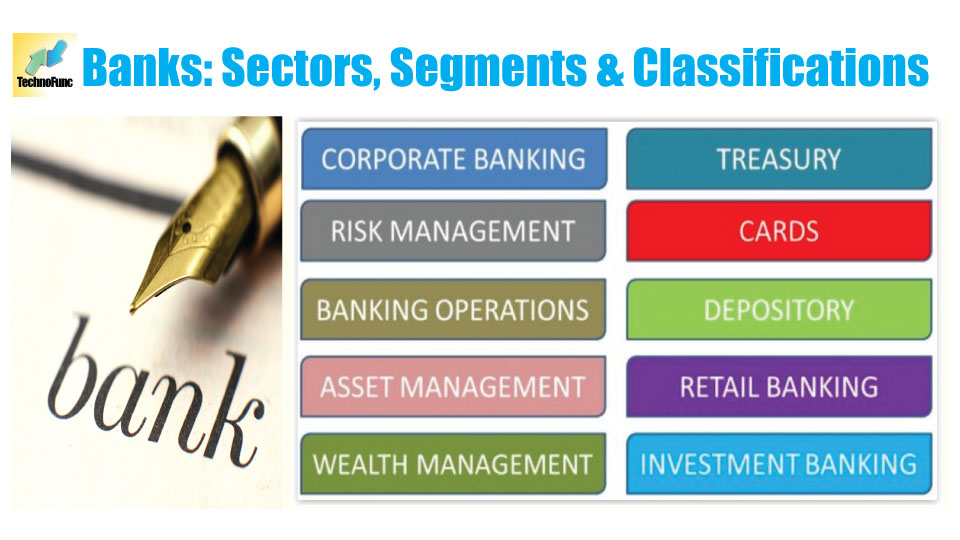- Home
- Business Processes
- Industry Knowledge
- Aerospace Industry
- Automotive Industry
- Banking Domain
- BFSI Industry
- Consumer/ FMCG Industry
- Chemicals Industry
- Engineering & Construction
- Energy Industry
- Education Domain
- Finance Domain
- Hospitality Domain
- Healthcare Industry
- Insurance Domain
- Retail Industry
- Travel and Tourism Domain
- Telecom Industry
- Leadership Skills
- eLearning
- Home
- Industry Knowledge
- Banking Domain
- Banking Sector, Segments & It's Classifications
Banking Sector, Segments & It's Classifications
The banking industry players deal in a variety of products from savings accounts to loans and mortgages, offer various services from check cashing to underwriting, caters to different types of customers from individuals to large corporates, serve diverse geographies from rural villages to cross-border operations. Thus the banking industry is made up of several types of banks, with their own objectives, roles, and functions. In this article, we will explore the various sectors, segments, and classifications of banking based on parameters like products, customers, types, etc.
The banking sector has witnessed enormous growth in the past decades. The banks have transformed themselves from traditional deposit and borrowing institutes to large organizations offering a variety of products and services. Banks can be classified in variety of ways based on various parameters like a statue, segments, customers, products and services, etc. Here we will discuss the most common classifications used in the Banking Industry:
• Banking Product Segments Prescribed by RBI
• Banking Geographical Segments Prescribed by RBI
• Key Banking Sectors Segments
• Key Banking Functions
Banking Product Segments Prescribed by RBI
 Reserve bank of India, prescribed four broad business segments in the year 2008, viz. ‘Treasury’, ‘Corporate / Wholesale Banking’, ‘Retail Banking’ and ‘Other Banking Business’. They have also prescribed ‘Domestic’ and ‘International’ as the uniform geographic segments for the purpose of segment reporting under accounting standard AS-17. These segments are briefly discussed below:
Reserve bank of India, prescribed four broad business segments in the year 2008, viz. ‘Treasury’, ‘Corporate / Wholesale Banking’, ‘Retail Banking’ and ‘Other Banking Business’. They have also prescribed ‘Domestic’ and ‘International’ as the uniform geographic segments for the purpose of segment reporting under accounting standard AS-17. These segments are briefly discussed below:
RBI Segment 1: Treasury
Treasury includes the entire investment portfolio comprising of funding and investment activities. Treasury management refers to the process of management of an enterprise's holdings, cash and working capital, with the ultimate goal of managing the firm's liquidity and mitigating its operational, financial, and reputational risk. Treasury Management provides greater insight and control over complex processes for managing funding, liquidity, and risk. Large banks have a stronghold on the provision of treasury management products and services.
RBI Segment 2: Retail Banking
The Retail Banking would include exposures which fulfill the four criteria of orientation, product, granularity, and low value of individual exposures. These retail exposures are laid down in the Basel Committee on Banking Supervision document "International Convergence of Capital Measurement and Capital Standards: A Revised Framework". Orientation Criterion refers to the exposure is to an individual person(s) or to a small business. Small business is one where the total annual turnover is less than INR 50 crores. Product criterion exposure means exposure on specified products specified as revolving credits, lines of credit, overdrafts, term loans, installment loans, student and educational loans, other leases, and small business facilities and commitments. It also includes housing loans. Granularity criterion mandates that the aggregate exposure to one borrower should not exceed 0.2% of the overall retail portfolio. Further, the ‘Low value of individual exposures’ criterion specifies the maximum aggregated retail exposure to one borrower at Rs.5 crore.
RBI Segment 3: Corporate / Wholesale Banking
Wholesale Banking includes all advances to trusts, partnership firms, companies and statutory bodies, which are not included under ‘Retail Banking’.
RBI Segment 4: Other Banking Business
Others banking business segment includes all other banking operations not covered under above 3 segments. It also covers all other residual operations such as para banking transactions.
Banking Geographical Segments Prescribed by RBI
 Geographic Segment 1: Domestic
Geographic Segment 1: Domestic
Consumer and business banking is mostly targeted to domestic customers residing within the country of registration. Domestic operations are the main market for the majority of deposits and advances.
Geographic Segment 2: International
Although generally, the domestic market is primary revenue source for most of the banks, banks also have significant global operations nowadays that contribute significantly to their revenues. Private and other global banks have much larger global operations and most of the smaller banks in India have comparatively smaller international operations.
Key Banking Sectors
 Based on types of banks and the products and services offered, the banks can be further classified as banking industry sectors in the following four ways:
Based on types of banks and the products and services offered, the banks can be further classified as banking industry sectors in the following four ways:
- Retail Banking
- Commercial Banking
- Investment Banking
- Central Banks
This classification into sectors is based on the customer profile and products and services offered by each type of bank.
Banking Industry Sector 1: Retail Banking
Retail banks are the banks that cater to the needs of individuals and the most common format of banking that we experience. They include deposit oriented banking institutions like saving banks, loan associations, credit unions, thrifts, and other savings banks like postal.
Individuals are the targeted consumers for retail banking and banks offer a variety of products and services to this clientele including savings accounts, safe lockers, fixed & recurring deposits, housing loans, consumer loans, personal loans, and unsecured and revolving loans, such as credit cards.
Banking Industry Sector 2: Commercial Banking:
This category represents corporate and business banking and includes commercial and foreign banks. Commercial banks offer similar kinds of products and services as retail banks, however, as retail banks target individual consumers, commercial banks are focused on corporates and commercial businesses. Products and services include consumer and commercial deposits, business loans, mortgage and real estate loans, overseas operations, investment in high-grade securities, and industrial loans.
Banking Industry Sector 3: Investment Banking:
The products and services of this category include managing portfolios of financial assets, trading in securities, fixed income, commodity and currency, corporate advisory services for mergers and acquisitions, corporate finance, and debt and equity underwriting. Trading activities include trading both on behalf of clients or on the bank's own account.
Banking Industry Sector 4: Central Banks:
Central banks are bankers’ banks, and every country generally has one central bank that occupies a central position in the banking system and acts as the highest financial authority. The main function of this bank is to regulate and supervise the whole banking system in the country. It is a banker's bank and controller of credit in the country.

Classification based on Key Banking Functions
 The banking industry is growing rapidly. It's estimated that the assets of the 1,000 largest banks are worth almost $100 trillion USD. With the growth in the industry, banks manage a diverse portfolio of functions. Apart from the segments discussed above banks also need to manage the following functions and can also be classified based on functions:
The banking industry is growing rapidly. It's estimated that the assets of the 1,000 largest banks are worth almost $100 trillion USD. With the growth in the industry, banks manage a diverse portfolio of functions. Apart from the segments discussed above banks also need to manage the following functions and can also be classified based on functions:
• Banking Operations(Personal & Commercial Banking comprises of personal banking operations and transactional banking)
• Clearing Functions (Internal and External Reconciliations & Internal and External Clearing)
• Asset Management (Provide asset management products and services)
• Wealth Management (High net worth clients with a full suite of investment, trust, and other wealth management solutions)
• Treasury & Risk Management (Provide custodial, advisory, financing, and other services for clients to safeguard assets, maximize liquidity and manage risk)
• Cards Issuance and Management (Issuance of credit cards and managing credit and operations for cards business)
• Trading Intermediary (Acting as Depository Participant, Registry, Exchanges, Trading or Broker-Dealer)
• Enabling Functions (Human Resources, Finance, Banking Technology, Surveillance, Legal and Compliance)
Banking Domain Knowledge - Resources
Related Links
You May Also Like
-
Definition of Bank: Meaning of the term Bank and the Business of Banking
What do we mean by the word bank? How did the word bank originate? What is the most simple and concise definition of a bank that explains the fundamentals of the banking process? Does the definition of banking vary from country to country? What are the key differentiators between any other business and a Bank? Get answers to all these questions and explore the basics of bank and banking as an industry.
-
History of Banking: Evolution of Banking as an Industry
Banking is one of the oldest industries and banking in the form that we know of began at about 2000BC of the ancient world. It started with merchants making grain loans to farmers and traders while carrying goods between cities. Since then, the banking industry has evolved from a simplistic barter system and gift economies of earlier times to modern complex, globalized, technology-driven, and internet-based e-banking model. In this article, we will take you through the major events and developments in the history of the banking industry.
-
History of Banking: Famous Banks from the Past
Seven hundred years ago a bank was established in Venice, which made transactions resembling modern banking. In 1407, another bank was founded in Italy under the name of Banco di San Giorgio which was one of the oldest chartered banks in Europe. Sveriges Riksbank (Riksbanken), is the central bank of Sweden and the world's oldest central bank. The Bank of England is the second oldest central bank in the world, and most modern central banks have been based on that model. Let us explore some interesting events as we learn more about these early banking institutions.
-
History of Banking: The Gold Standard & Fractional Reserve Banking
Gold has always been considered as a safe economic investment and treated like a currency. All of the economically advanced countries of the world were on the gold standard for a relatively brief time. Under a gold standard, the value of a unit of currency, such as a dollar, is defined in terms of a fixed weight of gold and banknotes or other paper money are convertible into gold accordingly. Explore the fascinating history of the gold standard through the lens of history and also learn why banks hold back a certain fraction of deposits as reserves.
-
Overview of Banking Industry: The Industry Basics
Banks play a key role in the entire financial system by mobilizing deposits from households spread across the nation and making these funds available for investment, either by lending or buying securities. Today the banking industry has become an integral part of any nation’s economic progress and is critical for the financial wellbeing of individuals, businesses, nations, and the entire globe. In this article, we will provide an overview of key industry concepts, main sectors, and key aspects of the banking industry’s business model and trends.
-
Banking Sector, Segments & It's Classifications
The banking industry players deal in a variety of products from savings accounts to loans and mortgages, offer various services from check cashing to underwriting, caters to different types of customers from individuals to large corporates, serve diverse geographies from rural villages to cross-border operations. Thus the banking industry is made up of several types of banks, with their own objectives, roles, and functions. In this article, we will explore the various sectors, segments, and classifications of banking based on parameters like products, customers, types, etc.
-
Type of Banks: Different Types of Banks in India & their Functions
This article explains the banking structure in India and how different banks are classified as per RBI Norms. The Indian banking industry has been divided into two parts, organized and unorganized sectors. The organized sector consists of Reserve Bank of India, Commercial Banks and Co-operative Banks, and Specialized Financial Institutions (IDBI, ICICI, IFC, etc.). The unorganized sector, which is not homogeneous, is largely made up of money lenders and indigenous bankers. Learn what we mean by nationalized banks, scheduled banks, public sector banks, private banks, and foreign banks.
-
Types of Banks: Different Banks & their Classifications (Global)
The banking industry caters to various sections of society thus the focus of banking becomes varied, catering to the diverse needs of clients through different products, services, and methods. To meet this, we need distinctive kinds of banks addressing complex business & social needs. In this article, we will explain various types of banking institutions ranging from retail banks, commercial banks, co-operative banks, investment banks, central banks to various other types of specialized banks.
-
Banking Operations: Understanding Various Transactions & Activities
Banks perform a variety of operations ranging from basic or primary functions like day to day transactions at a branch to others that maybe the agency or general utility services in nature. The transactions that are incidental to revenue/sales or sustaining the business are an important element of the banking industry value chain. In this article, we will look at the key operations performed in the course of banking.
-
Banking Industry Business Model - Understanding How the Banking System Works
Banks are commercial profitable institutions and need to increase their business, grow their revenue, and provide returns to their owners. Unlike other stores and shops, banks are providing services rather than selling their products. Learn how banks get their funds and how they make money on services. Read more to learn how the banks earn their profit!
Explore Our Free Training Articles or
Sign Up to Start With Our eLearning Courses

About Us
Learning
© 2023 TechnoFunc, All Rights Reserved










